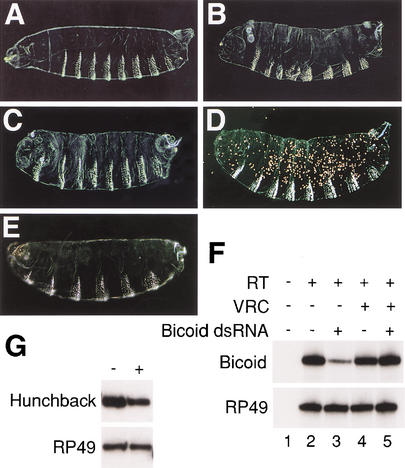Figure 1.
bicoid and hunchback are sensitive to RNAi. (A–E) Embryonic phenotypes with anterior to the left. (A) Cuticle phenotype of an embryo that had been injected with buffer at its anterior pole at stage 2. Its morphology resembles wild type. (B) Embryo from a bicoidE1 homozygous mother. Head and thoracic segments are missing in bicoid mutants, and the acron is partially or fully transformed into telson. (C,D) Cuticle phenotypes of embryos that were injected with bicoid dsRNA (C) or bombarded with gold particles coated with bicoid dsRNA (D). The cuticle in D is speckled in appearance owing to the embedded gold particles. The RNAi phenotypes are similar to the bicoid mutant. The penetrance of phenotype by injection is 100% (n = 42); the penetrance of phenotype by bombardment is 66% (n = 36). (E) Cuticle phenotype of embryo that was injected with hunchback dsRNA. The phenotype is similar to that of an embryo mutant for both maternal and zygotic hunchback. The penetrance of phenotype is 82% (n = 34). (F) Semiquantitative RT-PCR assay for bicoid and housekeeping gene RP49 mRNA levels. Pools of stage 2 embryos were coinjected with indicated combinations of bicoid dsRNA and vanadyl ribonucleoside complexes (VRC) in buffer, and total RNA was extracted at stage 4. RNA was reverse-transcribed (RT) as indicated, and bicoid or RP49 cDNA was amplified by PCR. The number of embryos per treatment is (lane 1) n = 13; (lane 2) n = 9; (lane 3) n = 17; (lane 4) n = 9; (lane 5) n = 15. There is a noticeable absence of bicoid protein/function but only a fourfold decrease in mRNA level. This has also been observed for other genes. One reason is that the RT-PCR assay only detects RNAi if the mRNA is cleaved within the region being amplified. Transcripts cleaved outside of the amplified region are counted as full length, even though they are null for protein/function. (G) RT-PCR for hunchback and RP49 mRNA levels from stage 4 embryos after injection with buffer (−) or hunchback dsRNA (+). The number of embryos is n = 18, n = 16, respectively.

